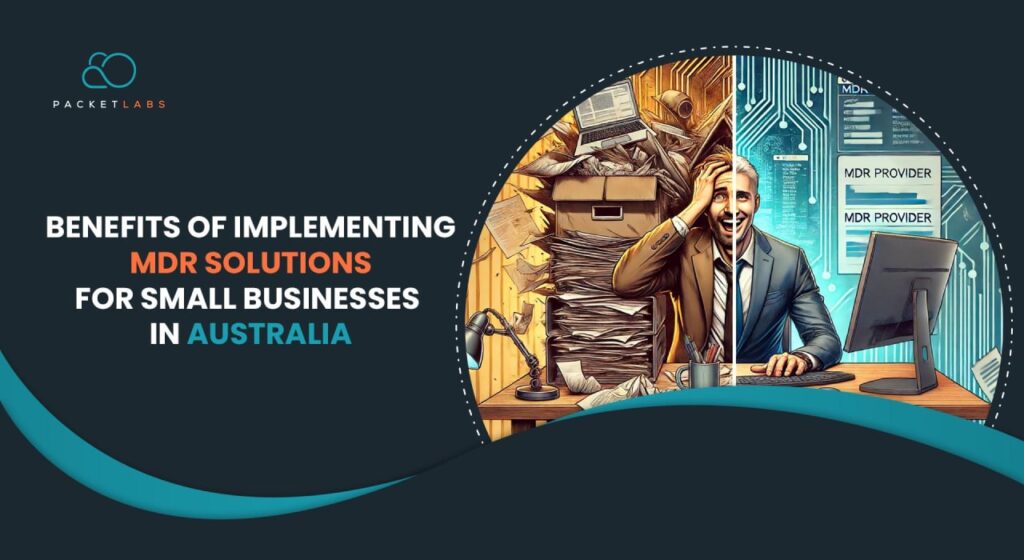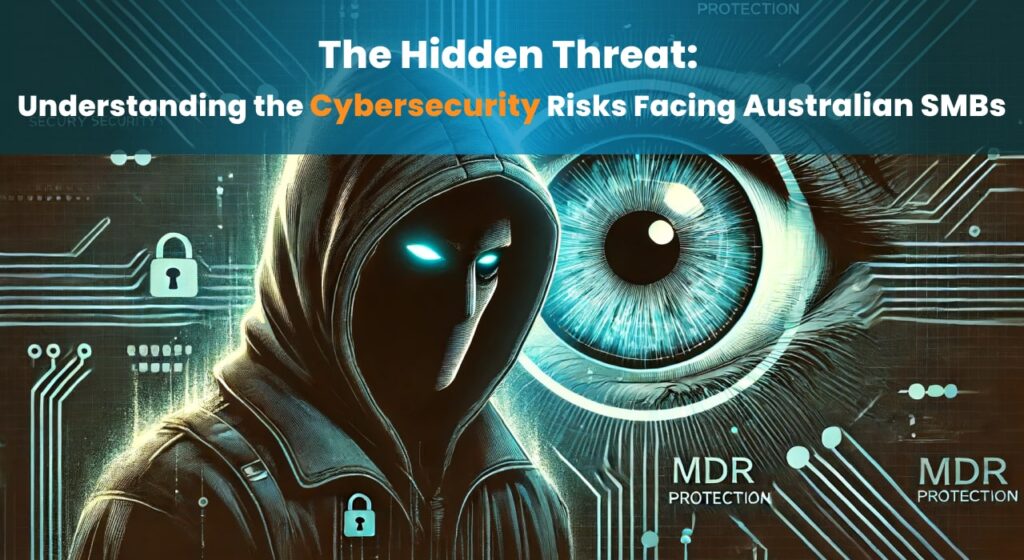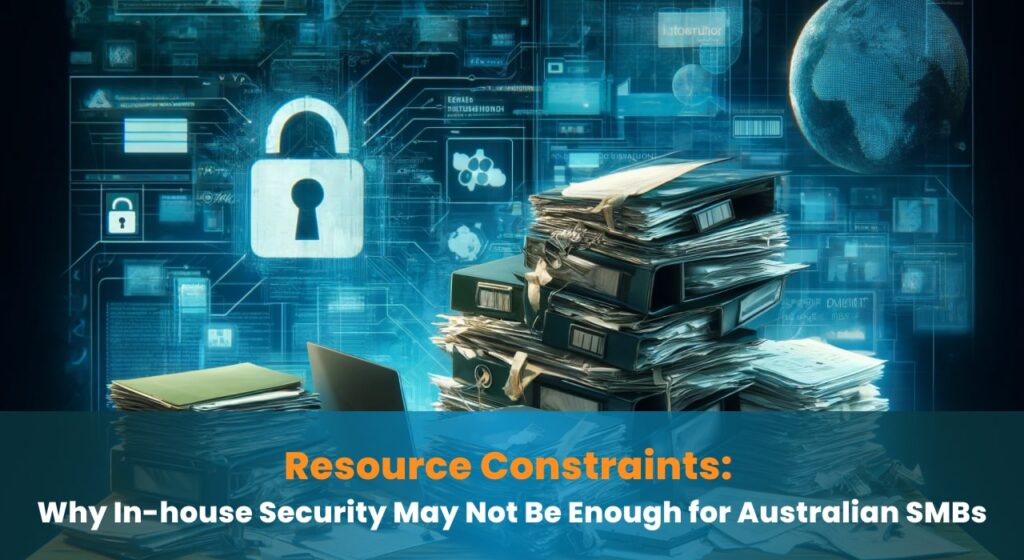
The Australian cybersecurity landscape is undergoing a significant shift. While large corporations have long been targets of sophisticated cyberattacks, small and medium-sized businesses (SMBs) are increasingly finding themselves in the crosshairs. In the 2022-23 financial year, the Australian Cyber Security Centre (ACSC) reported a staggering rise in cybercrime incidents, with one attack targeting Australian businesses occurring every six minutes. A recent example involved a local accounting firm whose systems were compromised by ransomware, leading to a week-long shutdown and significant financial losses. This incident highlights the vulnerability of SMBs, which often lack the robust cybersecurity defences of larger organisations.
Fortunately, advancements in cybersecurity technology offer potential solutions. Managed Detection and Response (MDR) is a service that provides continuous monitoring, threat detection, and incident response capabilities for businesses. By leveraging the expertise of security professionals and advanced tools, MDR can significantly bolster an SMB’s cybersecurity posture.
This article delves into the specific benefits of MDR solutions for Australian SMBs. We will explore how MDR can help businesses overcome their inherent security limitations, improve threat detection rates, and respond to incidents more effectively. By understanding the advantages of MDR, Australian SMBs can make informed decisions about safeguarding their critical data and infrastructure in today’s ever-evolving threat landscape.
The Australian Cyber Threat Landscape for Small Businesses

For many Australian small and medium-sized businesses (SMBs), the perception of being too small to attract cyberattacks is a dangerous fallacy. The Australian Cyber Security Centre (ACSC) paints a concerning picture, with their 2022-23 Annual Cyber Threat Report revealing a significant rise in cybercrime incidents targeting Australian businesses. The report states that on average, an attack targeting an Australian business occurs every six minutes. This translates to a relentless barrage of threats, highlighting the constant state of vigilance required for effective cybersecurity.
The sophistication of these attacks is also on the rise. Gone are the days of simple malware; cybercriminals are now employing a diverse arsenal of techniques specifically designed to exploit vulnerabilities in SMB systems. Phishing emails, meticulously crafted to appear legitimate, are a common weapon used to trick employees into revealing sensitive information or clicking on malicious links that can download malware. Ransomware attacks, where cybercriminals encrypt a business’s data and demand a ransom for its return, are another major threat. A recent example involved a local accounting firm whose systems were compromised by ransomware, causing a week-long shutdown and significant financial losses. This incident serves as a stark reminder of the devastating impact cyberattacks can have on Australian SMBs.
These are just a few examples of the ever-evolving threats faced by Australian SMBs. The sheer frequency and growing sophistication of cyberattacks underscore the critical need for robust cybersecurity measures.
Limitations of In-house Security for Small Businesses

While the importance of cybersecurity is undeniable, building and maintaining a robust in-house security team presents a significant challenge for many Australian SMBs. Unlike their larger counterparts, SMBs typically operate with limited resources, making it difficult to establish a dedicated team of cybersecurity professionals. The global cybersecurity workforce shortage further exacerbates this issue, making it challenging to find and retain qualified personnel with the expertise necessary to combat sophisticated cyber threats.
Beyond staffing limitations, keeping pace with the ever-evolving threat landscape poses another hurdle for SMBs. New attack vectors and malware variants emerge constantly, demanding continuous vigilance and adaptation of security strategies. Maintaining a comprehensive understanding of these evolving threats requires ongoing research and training, resources that may be stretched thin within an SMB. Implementing and enforcing best practices further complicates the picture. Ensuring employees are adequately trained in cyber hygiene protocols and implementing robust access controls requires consistent effort and oversight, tasks that can easily become neglected amidst the daily operations of an SMB.
Finally, the financial burden of building an in-house security team cannot be ignored. Hiring qualified cybersecurity professionals comes at a premium, and the cost of acquiring and maintaining advanced security tools can quickly strain an SMB’s budget. For many Australian SMBs, the sheer expense of in-house security simply outweighs the available resources.
What is an MDR Solution?

In the face of limited resources and a complex threat landscape, Managed Detection and Response (MDR) emerges as a compelling solution for Australian SMBs. MDR is a comprehensive cybersecurity service that offers continuous monitoring, threat detection, investigation, and incident response capabilities. Imagine having a dedicated team of cybersecurity experts working tirelessly behind the scenes to safeguard your business – that’s essentially what MDR provides.
MDR providers leverage a Security Operations Centre (SOC), a central hub staffed by security analysts who monitor a network of client systems 24/7. These analysts utilize advanced security tools and threat intelligence feeds to detect suspicious activity in real-time. Upon detecting a potential threat, the MDR team investigates the incident, determines its severity, and initiates a swift response to contain the damage and minimize disruption.
The key advantage of MDR lies in its proactive approach. Unlike traditional security solutions that simply react to threats after they occur, MDR proactively hunts for potential vulnerabilities and takes preventative measures. This continuous vigilance allows MDR providers to identify and address threats before they can significantly impact an SMB’s operations.
Benefits of MDR Solutions for Australian Small Businesses
For Australian SMBs grappling with limited resources and a rapidly evolving threat landscape, Managed Detection and Response (MDR) solutions offer a compelling set of advantages. MDR goes beyond traditional reactive security measures, providing a proactive and comprehensive approach to cybersecurity. Here’s how MDR empowers Australian SMBs to fortify their defenses:
- 24/7 Threat Monitoring and Detection: Cybercriminals don’t operate on a 9-to-5 schedule. MDR services provide continuous vigilance, monitoring your network for suspicious activity around the clock. This ensures that even after business hours, your systems are under the watchful eye of security experts, ready to identify and respond to potential threats before they escalate.
- Advanced Threat Detection Capabilities: Cyberattacks are becoming increasingly sophisticated, often employing techniques that can bypass traditional security tools. MDR providers leverage advanced security tools and threat intelligence feeds to identify these sophisticated threats. Machine learning algorithms and behavioral analytics allow MDR teams to detect subtle anomalies that might escape the notice of a basic security system.
- Faster Incident Response: Time is of the essence when dealing with a cyberattack. The quicker a security breach is identified and contained, the less damage it can inflict. MDR providers have established processes for rapid incident response. Upon detecting a potential threat, a team of security analysts investigates the incident, determines its severity, and initiates a swift response to contain the damage and minimize disruption to your business operations.
- Proactive Threat Hunting: Rather than simply reacting to threats, MDR services take a proactive approach by hunting for potential vulnerabilities within your systems. This proactive threat hunting involves security analysts actively searching for weaknesses in your network configuration, security controls, and applications. By identifying and addressing these vulnerabilities before they can be exploited, MDR helps to prevent cyberattacks from occurring in the first place.
- Access to Security Expertise: Building and maintaining a team of in-house cybersecurity professionals is a significant challenge for most Australian SMBs. MDR fills this gap by providing access to a team of security experts with the knowledge and experience to handle complex cyber threats. These experts are constantly monitoring the latest threat intelligence and attack vectors, ensuring your business stays ahead of the evolving cybercrime landscape.
- Reduced Costs: While there is a cost associated with MDR services, it can be a more cost-effective solution for Australian SMBs compared to building and maintaining an in-house security team. The expense of recruiting and retaining qualified cybersecurity personnel, coupled with the ongoing investment in security tools and training, can quickly become significant. MDR offers a scalable solution, allowing you to access a team of experts without the overhead costs associated with an in-house team.
| MDR Benefit | Addresses Limitation |
|---|---|
| 24/7 Threat Monitoring and Detection | Limited Staff Availability |
| Advanced Threat Detection Capabilities | Lack of Expertise |
| Faster Incident Response | Difficulty Maintaining Best Practices |
| Proactive Threat Hunting | Inability to Stay Updated on Threats |
| Access to Security Expertise | Resource Constraints |
| Reduced Costs | High Cost of In-house Security Teams |
By addressing the limitations of in-house security, MDR empowers Australian SMBs to achieve a more robust cybersecurity posture. This translates to greater peace of mind, allowing you to focus on your core business activities with the confidence that your data and infrastructure are protected.
Choosing an MDR Provider in Australia

Selecting the right MDR provider is a crucial step for Australian SMBs seeking to bolster their cybersecurity posture. Several key factors should be considered during the evaluation process.
- Experience and Expertise: Prioritize MDR providers with a proven track record of success in securing similar business environments. Look for providers who possess deep industry knowledge and a team of security professionals with demonstrably strong technical skills and experience in handling cyber threats.
- Security Certifications: Security certifications held by the MDR provider offer valuable insights into their commitment to security best practices and adherence to industry standards. Look for internationally recognized certifications like ISO 27001 (security management) and SOC 2 (secure data handling).
- Services Offered: Ensure the MDR provider offers a comprehensive suite of services that aligns with your specific needs. This might include 24/7 threat monitoring, proactive threat hunting, and swift incident response capabilities. Consider the level of customization offered by the provider – can they tailor their services to address your unique vulnerabilities?
- Cost Structure and Pricing Models: MDR services come with varying cost structures. While upfront costs are important, consider the total value proposition. Transparent pricing models that detail service inclusions and potential additional fees are essential for informed decision-making.
- Compatibility with Existing IT Infrastructure: A seamless integration with your existing IT infrastructure is crucial for maximizing the effectiveness of MDR services. Evaluate whether the MDR provider’s solution is compatible with your current security tools and operating systems.
By carefully considering these factors, Australian SMBs can make an informed choice when selecting an MDR provider, ensuring they receive the most effective and comprehensive cybersecurity protection available.
In the ever-evolving cyber threat landscape, Australian SMBs face a constant barrage of sophisticated attacks. Building and maintaining robust in-house security capabilities can be a significant challenge for resource-constrained businesses. This is where Managed Detection and Response (MDR) emerges as a compelling solution.
MDR offers a comprehensive and proactive approach to cybersecurity, empowering SMBs to overcome their inherent security limitations. By providing continuous monitoring, advanced threat detection, and rapid incident response, MDR safeguards valuable data and minimizes disruption to business operations. Furthermore, access to a team of security experts ensures your organization stays ahead of the evolving cybercrime curve.
The value proposition of MDR is undeniable. By investing in MDR services, Australian SMBs can achieve a more robust cybersecurity posture, mitigating cyber risks and fostering peace of mind. Don’t let your business become a cybercrime statistic. Invest in robust cybersecurity solutions. Explore MDR solutions today and ensure your valuable data and operations are protected from the ever-present threats of the digital age.
